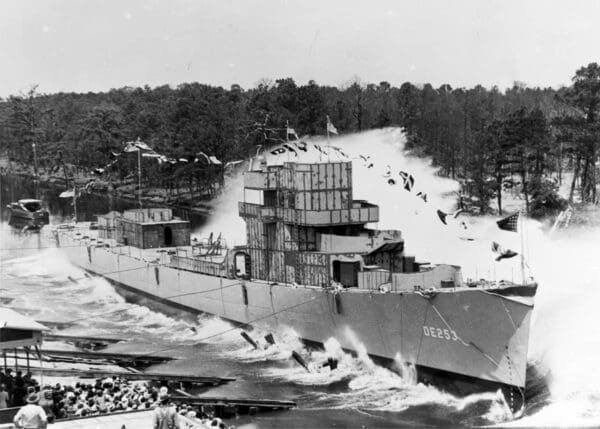01. Shipyard History
History
Brown Shipbuilding was located in Houston, Texas, from 1941 to 2004. Brown Shipbuilding was formed as a subsidiary of the engineering and construction company, Brown & Root. The shipyard was established to build ships for World War II (WWII).
During WWII, Brown Shipbuilding employed more than 25,000 workers and constructed approximately 350 ships. Many of the ships were submarine chasers, destroyer escorts and amphibious assault craft.
After WWII, the yard was sold to Todd Houston Shipbuilding Company, which ran it until 1985. It was bought back by Brown & Root, which managed it as a barge and large vessel repair yard until 2004. The shipyard was then broken up and sold to various companies.
Brown Shipbuilding History at a Glance
- Other Names: Brown & Root
- Location: The junction of Greens Bayou and the Houston Ship Channel in Houston, Texas
- Owner(s): George and Herman Brown, Brown & Root
- Years of Operation: 1941 – 2004
- Wartime Operations: World War II (WWII)
- Number of Employees: 25,000 during WWII
- Noteworthy Ships: USS Stewart, USS Howard D. Crow, USS Pettit, USS Richey, USS Calcaterra, USS Chambers, USS Haverfield, USS Richard M. Rowell, USS Eversole, USS La Prade, USS Jack Miller, USS LeRay Wilson, USS Oliver Mitchell, USS Robert F. Keller
- Types of Ships Built/Serviced: Submarine chasers, destroyer escorts, amphibious assault crafts
Many workers at Brown Shipbuilding were potentially exposed to asbestos. Workers’ loved ones may have also experienced secondhand exposure. As a result, many people developed asbestos-related diseases, such as asbestosis, asbestos lung cancer, pleural mesothelioma and peritoneal mesothelioma. People who developed an asbestos-related disease may be eligible for compensation.
Notable Ships Built and Repaired
Approximately 350 ships were built at Brown Shipbuilding during WWII. Many of these ships remained active after the war. Some notable ships included the USS Robert F. Keller and the destroyer escort, USS LeRay Wilson.
USS Robert F. Keller
The USS Robert F. Keller was laid down by Brown Shipbuilding in 1944. The ship participated in WWII as part of the Pacific Fleet in Iwo Jima and Okinawa in 1945. After WWII, she was assigned to Puget Sound Naval Shipyard as part of the Navy’s Reserve training program.
In 1950, the ship was moved to Washington, D.C., to continue participating in training activities. By 1955, the USS Robert F. Keller had trained more than 3,500 sailors.
During the Berlin Crisis of 1961, the USS Robert F. Keller was briefly recommissioned. The ship returned to training until officially being decommissioned in 1965.
The asbestos used on board the USS Robert F. Keller has put thousands of crew members, workers and trainees at risk of developing asbestos-related diseases.
SS LeRay Wilson
The destroyer escort, USS LeRay Wilson, was laid down by Brown Shipbuilding in 1943. She immediately launched into WWII as part of the Pacific Fleet.
She was in active battle with the Japanese and was part of the capture and occupation of Okinawa. The USS LeRay Wilson was also in Tokyo Bay for the Japanese surrender.
The USS LeRay Wilson was decommissioned in 1947. The Navy recommissioned the ship for the Korean War in 1951. Unutilized for the war, she went on peacekeeping missions to the Far East before being decommissioned in 1959 and entering the Pacific Reserve Fleet.
Asbestos was used heavily in shipbuilding at the time the USS LeRay Wilson was constructed and served. Anyone working on or serving aboard the ship during its service may be at risk of developing mesothelioma.
02. Shipyard Asbestos Use
Asbestos Use at Brown Shipbuilding
Asbestos is highly heat resistant and durable. Thus, it was used in many aspects of ship construction. Shipbuilders used asbestos to prevent fires and control the amount of heat released by heavy equipment.
Brown Shipbuilding was very active during WWII. During this time, asbestos use was very common. At Brown Shipbuilding, asbestos was used as insulation in walls, boilers, incinerators and around pipes. As a result, workers came in contact with many products that put them at risk of asbestos-related diseases.
Asbestos Exposure at Brown Shipbuilding
Shipyards were staffed by military personnel and civilians. Because asbestos use in shipyards was so common, veterans of the U.S. Navy were frequently exposed. However, anybody who worked at Brown Shipbuilding from the 1930s through the 1980s was at high risk of exposure and could develop malignant mesothelioma cancer.
Anyone who serviced submarine chasers, destroyer escorts, amphibious assault crafts or other ships at Brown Shipbuilding faced a similar risk. Frequent use and a lack of ventilation on ships made asbestos exposure commonplace. For example, construction and maintenance workers were exposed when working in boiler rooms.
Even today, people can be exposed to asbestos when working on older ships. Workers can be exposed during maintenance or decommissioning of ships built before the 1980s. A variety of duties, such as replacing pipes or repairing old boilers, can expose workers to asbestos.
03. Asbestos Lawsuits
Asbestos Lawsuits and Settlements
People who worked on ships at Brown Shipbuilding are at risk of developing asbestos cancer or other related diseases. After a diagnosis, these shipyard workers have compensation options.
Victims can be compensated by the companies that exposed them to asbestos. Their compensation options depend on the status of that company. Victims can work with a mesothelioma lawyer to secure payment from a lawsuit, settlement, trust fund and/or VA claim (or a combination of these types of claims).
Holding Asbestos Companies Responsible
Some asbestos-producing companies are still operational and have not filed for bankruptcy. Individuals can still file asbestos lawsuits against such companies. Asbestos lawsuits can result in verdicts or settlements.
Uniroyal Holding, Inc. manufactured asbestos-containing products, including insulation, that were used at Brown Shipbuilding. People who worked with these products were wrongfully exposed to asbestos.
Another example of a viable company is Crown, Cork & Seal Company. In 1963, Crown, Cork & Seal Company bought Mundet, a firm that made cork bottle caps and insulation that contained asbestos. This insulation was used in shipyards and exposed workers and crews to asbestos-related diseases such as mesothelioma.
Several victims have filed successful lawsuits against these asbestos companies.
04. Filing Asbestos Claims
Asbestos Company Trusts
Wrongful asbestos exposure and the resulting lawsuits have contributed to more than 100 companies filing for bankruptcy in the last 20 years. As part of the bankruptcy process, many asbestos companies created trust funds. Asbestos trust funds provide compensation for current and future victims of asbestos-related conditions.
As part of their job duties, many shipyard employees came into contact with asbestos. Shipyard workers who developed an asbestos-related disease are eligible to file an asbestos claim with the product manufacturer’s trust.
Asbestos Company Trust Funds and Eligible Years of Employment
The following companies provided asbestos products to Brown Shipbuilding. After facing many asbestos lawsuits and exposing innocent people to asbestos, these companies filed for bankruptcy and created trusts to pay victims. If an individual worked at Brown Shipbuilding and developed a disease, such as mesothelioma, they may be able to file a claim against these companies’ trusts.
| Asbestos Trust Funds & Eligible Years of Employment | ||
|---|---|---|
| Asbestos Company Name | Eligibility Start Date | Eligibility End Date |
| Babcock & Wilcox | 4/1/1945 | 12/31/1982 |
| Combustion Engineering | 1/1/1964 | 12/31/1982 |
| Fibreboard | 1/1/1941 | 12/31/1982 |
| J.T. Thorpe Successor Trust | 1/1/1956 | 12/31/1982 |
| Keene Corp. | 1/1/1968 | 12/31/1982 |
| NARCO | 1/1/1956 | 3/31/1980 |




